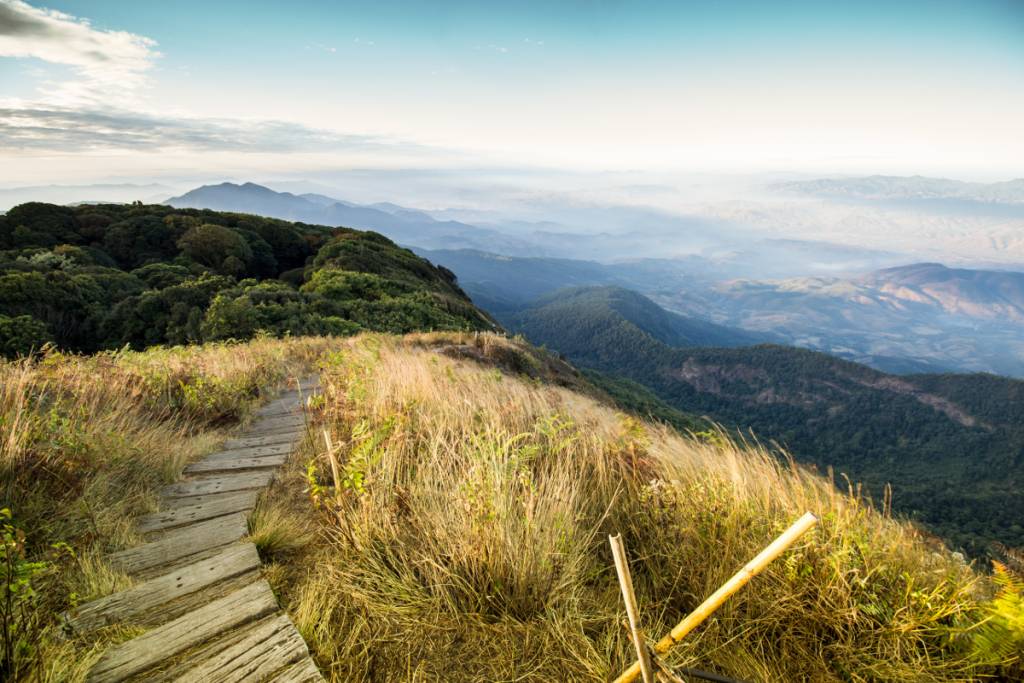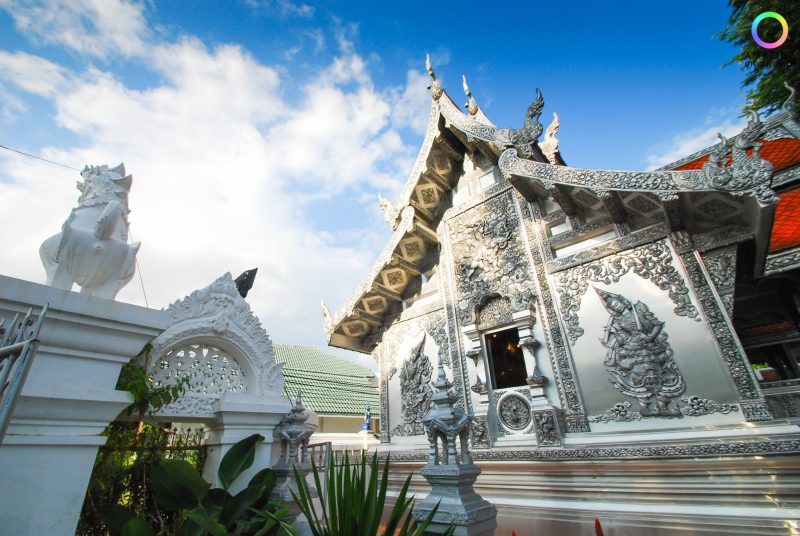 |
| Chiang Mai Province that you do not know yet | |
Chiang Mai as name “จังหวัดเชียงใหม่” It is a province in the north of Thailand. It covers an area of approximately 20,107 square kilometers. Which is the second largest in the country with a population of about 1.76 million people, the fifth largest in the country, of which 960,000 people live in urban and suburban areas. Chiang Mai has an urban area that is the second largest city in Thailand (ประเทศไทย) after Bangkok (กรุงเทพ). With a population of 960,906 in urban and suburban areas (2010), Chiang Mai Province is divided into 25 districts, with Mueang Chiang Mai District as the center of the province. 25th of the province and number 878 of the country, which is the latest district of Thailand. Chiang Mai has a long history. It used to be the capital of the Lanna Kingdom since ancient times, with “Kham Muang” in the local language. It is unique in terms of traditions and culture. And there are many tourist attractions. by starting to act as a creative city and was declared the world’s creative city for handicrafts and folk arts in 2017. Currently, it is considering applying for a UNESCO World Heritage City. Chiang Mai is also regarded as the astronomical center of Southeast Asia, which is home to the National Observatory and the National Astronomical Park. Chiang Mai Province has an area of 20,107.057 square kilometers, or approximately 12,566,911 rai, with an area that is the largest in the North and the 2nd in the country after Nakhon Ratchasima. The topography is generally mountainous and scrubland. There is a plain in the middle along both sides of the Ping River. The highest mountain in Thailand is Doi Inthanon, about 2,565 meters high, in Chom Thong district. There are also several other mountains that have a lower height such as Doi Pha Hom Pok (Fang District), 2,285 meters high, Doi Luang Chiang Dao (Chiang Dao District) height 2,170 meters Doi Suthep (Mueang Chiang Mai District) height 1,601 meters, the area can be divided into 2 types: Mountain area, accounting for approximately 80 percent of the province, consists of the Inthanon Mountain Range. (Or Thanon Thongchai East) is located in the west of the province. stretching from north to south Along the border with Mae Hong Son Province and the Khun Tan mountain range which is located in the east of the province Passing in the north-south.Most of the mountainous areas are forested upstream. unsuitable for cultivation Some areas are inhabited areas of various ethnic hill tribes. Alluvial plains and hilly plains Distributed throughout the valley stretching in the north-south line, including the Ping River Basin, Fang River Basin, Mae Ngat Basin It is an area that is fertile and suitable for agriculture. Chiang Mai has many types of forests, including hill evergreen forest, dry evergreen forest, mixed deciduous forest, mixed deciduous dipterocarp forest, pine forest and red forest, etc. The forest area consists of natural forest, forest plantation and natural regeneration forest. There are forest areas in Chiang Mai province of 12,222,395 rai, representing 69.93% of the total area of the province. It is divided into 25 national forest reserves, 14 national parks, 4 wildlife sanctuaries, 2 national parks and no hunting zones. 1 wildlife and Chiang Mai province is also regarded as the province that has the closest urban area to the national park area in the country as well. National Parks in Chiang Mai Province are:
In addition, Chiang Mai has problems with forest resources occurring regularly. important reasons such as illegal logging Invasion for agriculture and forest fires. Chiang Mai has an important river, the Ping River, and has two large water sources, the Mae Kuang Udom Thara Dam. Doi Saket District and Mae Ngat Somboon Chon Dam, Mae Taeng District. Chiang Mai Province is home to the following consulates: Consulate Generals of the United States of America, Japan, the People’s Republic of China, India and the Consulate General of Myanmar. Honorary Consulates include: Honorary Consulates of Germany, Portugal, France, Australia, Austria, Canada, Italy, Peru, Bangladesh, Sweden, Greece, South Korea, Philippines, Finland, Netherlands and Honorary Consulate of Switzerland. Population in Chiang Mai 91.8 percent Buddhism, 5.6% Christianity, 1.17% Islam, 0.02% Hindu and Sikhism, and 1.41% other. In the World Best Award-Top 10 Cities survey from readers of Travel and Leisure, a US travel magazine in 2010, Chiang Mai was the second most attractive city in the world, behind only Bangkok. 2009 Chiang Mai was ranked as the 5th most attractive city in the world, considering its location, scenery, beauty and shady. Arts, culture and traditions, food, shopping friendliness of people, value for money, etc. Chiang Mai tradition (ประเพณีภาคเหนือ) Chiang Mai has a long history. Chiang Mai people have continually accumulated cultural traditions inherited from their ancestors. Most of them are related to Buddhism and traditional beliefs. Important traditions include:
Chiang Mai attractions (รวมสถานที่ท่องเที่ยวเชียงใหม่ยอดนิยม) Natural attractions: Chiang Dao Wildlife Sanctuary Chiang Dao District, Doi Mon Jong, Omkoi District, Doi Ang Khang, Fang District, Doi Tao Lake, Doi Tao District, Fang Hot Springs, Fang District, San Kamphaeng Hot Springs, Mae On District, Mae Taeng Elephant Camp, Mae Taeng District, Mon Chaem, Mae Rim District, Queen Sirikit Botanical Garden, Mae Rim District, Doi Pha Hom Pok National Park, Mae Ai District, Doi Suthep-Pui National Park Mueang Chiang Mai District, Ob Luang National Park, Hot District, Doi Inthanon National Park, Chom Thong District General attractions: Mueang Chiang Mai District, Phuping Krachaniwet Palace, Chiang Mai Zoo North food (อาหารเหนือ) local food It is a popular food. Many great menus from the north You are in the middle of the valley where the weather is cool. Served with many different types of dipping sauces, pungent flavor, eaten with warm sticky rice. Northern food has been influenced by the Lanna kingdom. and Northeast until it was praised and dubbed as Lan Na rice. The difference between northern food And Isan food is the taste of northern food. It is not hot like Isan people. It has a milder, salty and sour taste, but not sweet. Famous dishes include Khao Soi, Hang Lay Curry and Sai Oua. Vegetables commonly used in cooking are kae, bon, yak kluai, and sweet vegetables. Northern cuisine is unique in that it combines the cultural mix of various ethnic groups such as Chinese Hor, Tai Lue, Thai Yai, and indigenous peoples. There are many methods of cooking, such as curry, stirring, screening, frying, spinning, piping, boiling, and lowering. Northern food is often cooked very much, such as stir-fried vegetables. Often stir-fried until the vegetables are soft. Khantoke in the north is a charming, unique, delicious recipe, along with local vegetables. These usually consist of Kaeng Kae, Hang Lei, Kaeng Ho, Kanom Jeen Nam Ngiao, and Khao Soi, among others. North food Due to the relatively cold climate, most of the northern dishes are very fatty, such as Gang Hung Lay, Nam Prik Ong and Sai Oua. These northern dishes were invented by northern people’s wisdom. To help the body to be warm to withstand the cold climate. Northern tradition and northern culture Born from a combination of lifestyle and religion, it is unique and varies according to the season. There are festivals held every month such as Songkran Tradition, Wan Nao, Wan Ya Wan, Nang Maeo Parade, Poi Noi Tradition, Kaew Luk Ordination Tradition, Poi Luang Tradition, Yi Peng Tradition, Lantern Festival Tradition, Tan Tung Tradition. and the tradition of lottery cones. | |
Post by Kittisak :: Date 2021-06-17 12:38:31 IP : 49.49.249.218 |
| Copyright © 2010 All Rights Reserved. |
| Visitors : 631382 |




